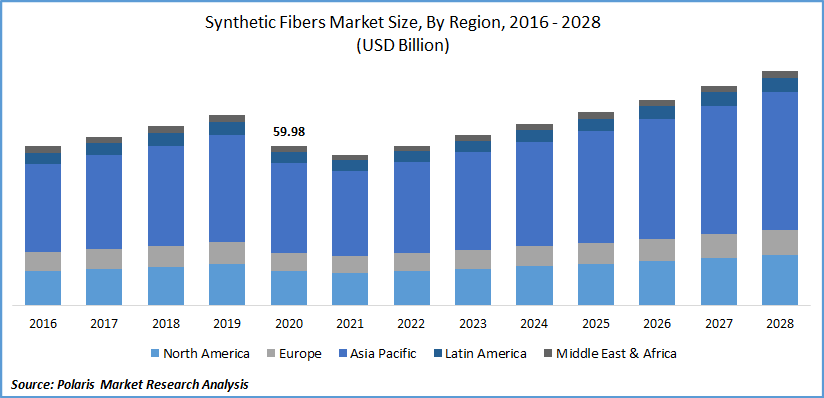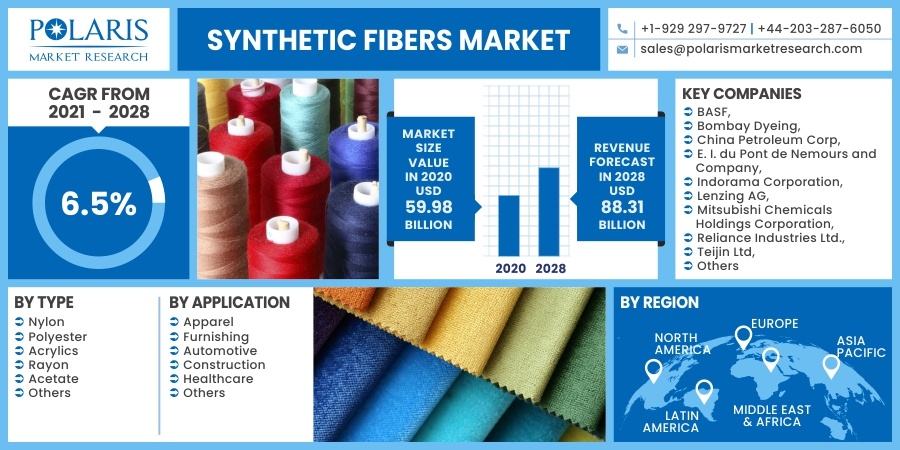
Synthetic Fibers Market Share, Size, Trends, Industry Analysis Report, By Type (Nylon, Polyester, Acrylics, Rayon, Acetate, Others); By Application; By Region; Segment Forecast, 2021 - 2028
- Published Date:Oct-2021
- Pages: 110
- Format: PDF
- Report ID: PM1988
- Base Year: 2020
- Historical Data: 2016 - 2019
Report Outlook
The global synthetic fibers market size was valued at USD 59.98 billion in 2020 and is expected to grow at a CAGR of 6.5% during the forecast period. Synthetic fibers are produced through chemical processing of petroleum and coal-derived polymers or chemical modification of naturally occurring materials. Synthetic fibers, such as nylon, polyester, and acrylic fibers, are increasingly being used as an alternative to natural fibers owing to their cost-effectiveness and ease of mass production.
Synthetic fibers offer greater durability, high water and heat resistance, and protection against chemical degradation. Properties of synthetic fibers can be altered to meet the demand of specific applications through modification of chemical composition and process conditions. They are designed to be more stain-resistant, waterproof, and water-resistant than natural synthetic fibers. These synthetic materials are used in varied applications such as apparel, automotive, home furnishing, and household, among others.
 Know more about this report: request for sample pages
Know more about this report: request for sample pages
The COVID-19 outbreak has restricted the growth of the market due to the impact of operational challenges, disruption of supply chain, reduced demand, and workforce impairment. The pandemic has adversely affected industries such as automotive, home textile, and apparel, resulting in reduced demand for synthetic fibers.
Manufacturing activities have been halted due to various government regulations across the globe. The supply of raw material has been impacted owing to lockdown, roadblocks, and restrictions on the movement of goods from the Asia-Pacific region. The closure of stores and malls across the globe has further affected the market. However, medical-grade synthetic products are being used in health, hygiene, and cleaning segments during the pandemic. The market is expected to be restored post-COVID-19 due to supportive government regulations, increasing application in diverse sectors, and opening of distribution channels.
Industry Dynamics
Growth Drivers
The global synthetic fibers market is driven by rising disposable income of consumers, improving lifestyles, and greater demand for cost-effective and easy-to-maintain fabrics. Rising urbanization and growing demand from the automotive and furnishing sectors have accelerated the adoption of synthetic fibers. There has been increasing use of synthetic fibers to manufacture upholstery, blankets, carpets, and wall coverings.
The market is also influenced by growing adoption of western culture in emerging economies and rapidly changing fashion trends. There has been an increasing application of synthetic materials in the automotive sector. The rise in demand for passenger vehicles, growing modernization of vehicles, and increasing penetration of luxury vehicles further influence the growth of the market. New product launches and acquisitions by leading players in the market coupled with improvement in manufacturing processes have increased the demand for synthetic fibers across the globe.
Polyester is a commonly used synthetic fiber produced from coal and petroleum. Fabric made from polyester offers strength, stain resistance, high elasticity, and superior wrinkle and abrasion resistance. It is used to manufacture products such as home furnishings, apparel, upholstery padding, and upholstered furniture.
The various applications of industrial polyester fibers include conveyor belts, tire reinforcements, and safety belts, among others. However, polyester is non-biodegradable and decomposes slowly, which raises several environmental concerns with its usage. Another common fiber is nylon. Nylon fibers provide greater strength and elasticity as compared to polyester. The fabric formed with nylon material is lightweight, soft, tough, easy to wash, and abrasion-resistant. Some applications of nylon include garment, home furnishing, tire cords, seat belts, carpets, parachutes, sleeping bags, and tents.

Know more about this report: request for sample pages
Report Segmentation
The market is primarily segmented on the basis of type, application, and region.
|
By Type |
By Application |
By Region |
|
|
|
Know more about this report: request for sample pages
Insights by Type
The type segment has been divided into nylon, polyester, acrylics, rayon, acetate, and others. The demand for polyester is expected to be high during the forecast period owing to wide use in apparel and home furnishing. Polyester is a popular synthetic fiber offering durability and abrasion resistance. Use of polyester synthetic fibers provides enhanced flexibility, shape retention, chemical resistance, and easy washability due to its hydrophobic nature. Polyester fibers are highly stain-resistant and can be dyed only through dispersed dyes. Industrial polyester fibers are used in applications such as conveyor belts, tire reinforcements, safety belts, and in plastic reinforcements with high-energy absorption.
Insights by Application
On the basis of application, the market is segmented into apparel, furnishing, automotive, construction, healthcare, and others. The apparel segment dominated the global market in 2020. Increasing disposable income and improving living standards have increased the market demand for comfortable and cost-effective clothing options. Synthetic fibers are made from either inorganic products or a mixture of organic products and chemicals. These synthetic materials offer various properties such as strength and durability, quick-drying, and ease of dyeing, among others.
Geographic Overview
Asia-Pacific dominated the global market in 2020. Increasing urbanization, growing automotive industry, expansion of international players in this region, and technological advancements are some factors attributed to the growth of this region. Increasing demand from apparel and furnishing industries in developing countries boosts market growth. The industrial development in countries such as China, India, and Japan, rising application in construction and healthcare sectors further influences market growth.
Competitive Landscape
The leading players in the synthetic fibers market include BASF, Bombay Dyeing, China Petroleum Corp, E. I. du Pont de Nemours and Company, Indorama Corporation, Lenzing AG, Mitsubishi Chemicals Holdings Corporation, Reliance Industries Ltd., Teijin Ltd, The CHA Textiles Group, Toray Chemical Korea Inc, Toyobo Co., Ltd. These players are expanding their presence across various geographies and entering new markets in developing regions to expand their customer base and strengthen presence in the market. The companies are also introducing new innovative products in the market to cater to the growing consumer demands.
Synthetic Fibers Market Report Scope
|
Report Attributes |
Details |
|
Market size value in 2020 |
USD 59.98 billion |
|
Revenue forecast in 2028 |
USD 88.31 billion |
|
CAGR |
6.5% from 2021 - 2028 |
|
Base year |
2020 |
|
Historical data |
2016 - 2019 |
|
Forecast period |
2021 - 2028 |
|
Quantitative units |
Revenue in USD billion and CAGR from 2021 to 2028 |
|
Segments covered |
By Type, By Application, By Region |
|
Regional scope |
North America, Europe, Asia Pacific, Latin America, Middle East & Africa |
|
Key Companies |
BASF, Bombay Dyeing, China Petroleum Corp, E. I. du Pont de Nemours and Company, Indorama Corporation, Lenzing AG, Mitsubishi Chemicals Holdings Corporation, Reliance Industries Ltd., Teijin Ltd, The CHA Textiles Group, Toray Chemical Korea Inc, Toyobo Co., Ltd |
